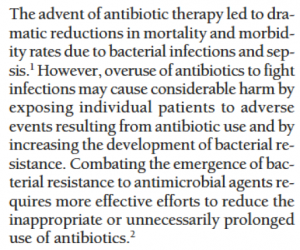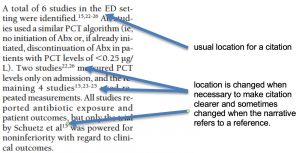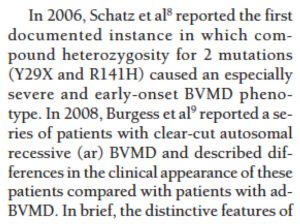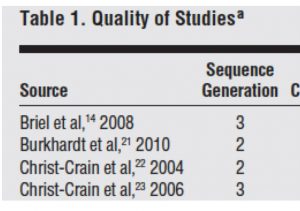5. AMA 11th Style
Objectives:
- know how to use numeric in-text citations
- become familiar with AMA 11th style, in-text-citation and reference-list format
“AMA 11th”-style In-text Citations
The AMA 11th edition citation style like many other citation styles uses superscript numbers inserted in the text to refer to numbered entries in the reference list.
In the AMA 11th style
- Superscript reference numbers are used for in-text citations (Example 1).
Example 1

(Text in examples 1-4 was taken from: Schuetz P, Chiappa V, Briel M, Greenwald JL. Procalcitonin algorithms for antibiotic therapy decisions: A systematic review of randomized controlled trials and recommendations for clinical algorithms. Arch Intern Med. 2011;171(15):1322.)
- The first resource cited is given the number 1, the second resource cited is given the number 2, etc. Consequently, the resources (references) are listed at the end of the article in order of their citation .
- In-text citations are usually placed after punctuation marks at the end of phrases/sentences. An exception to this rule is seen when the text mentions the resource/reference (see example below).
Example 2

- Commas are used to separate numbers for two references cited in a single location (e.g. 1,2 ) or numbers for multiple discontinuous references cited in a single place (e.g. 1,2,5,7).
Example 3

- A hyphen is used between first and last citation numbers when more than two references in sequence are cited in a single place (e.g. 1-3 ).
Example 4

- Some of you may have used (author, year) in-text citations in the past. Remember, in AMA style, a number is needed even if the author and year are in the text or table. This is because the reference list is not in alphabetic order, but rather in numeric order (according to citation number).
Example 5

Example 6

(Examples 5 and 6 are Iannaccone A, Kerr NC, Kinnick TR, Calzada JI, Stone EM. Autosomal recessive best vitelliform macular dystrophy: Report of a family and management of early-onset neovascular complications. Arch Ophthalmol. 2011;129(2):211.)
AMA 11th edition is not the only citation style that uses superscript numbers for in-text citations. When superscript numbers are used, they are, virtually always, used as described above.
“AMA 11th”-style Reference List Format
If you decide to create your reference list manually, you will need to be very careful when numbering your in-text citations and formatting your reference list. Even if you use Zotero or another citation manager (e.g. RefWorks, or EndNote) to insert your citations and reference list, it’s important that you check the format of your reference list entries. Rules for, and examples of, AMA 11th style reference list entries are provided below:
General rules
- If there are more than 6 authors or editors, list the first 3 authors followed by, et al.
- Authors or editors names are all shown as
Last FM,
or
Last F,
- Sentence case (first letter of title capitalized) is usually used for the title an item/article/chapter that is a section of something else (book/monograph set/database). Title case (first letter of all words longer than 2 or letters is captialized) is used for the title of the something else. (E.g. Fluoxetine hydrochloride. In: PubChem.)
- Periodical titles are abbreviated using abbreviations found in PubMed (NLM title abbreviations). Abbreviated words in the periodical titles are not followed by periods. You can look up a journal’s NLM title abbreviation at: https://www.ncbi.nlm.nih.gov/nlmcatalog/journals/
- Periodical abbreviations and book titles are italicized.
- When you use a specific chapter and/or monograph, cite the specific chapter and/or monograph – not the entire book or compendium.
- Reference list entries for resources other than journal articles require the publisher’s name. The previous edition of the AMA style (AMA 10th) required the publisher’s location as well, but locations are no longer required in AMA 11th.
- Reference list entries that end in a doi or web address are not followed by a period. Periods interfere with auto-link creation. Other reference list entries should be followed by a period.
Journal Article
Printed article or article with print-style page number range (ex. 8-16) but no doi.
-
Thiesing JT, Ohno-Jones S, Kolibaba KS, Druker BJ. Efficacy of STI571, an abl
tyrosine kinase inhibitor, in conjunction with other antileukemic agents against
bcr-abl-positive cells. Blood. 2000 Nov 1;96(9):3195-9.
To compare the position of the pieces of information in the citation above and in a PubMed record, click here to open the PubMed record in a new tab.
Article available in print and online that has a doi.
- Capuozzo A, Montefusco S, Cacace V, et al. Fluoxetine ameliorates mucopolysaccharidosis type IIIA. Mol Ther. 2022;30(4):1432-1450. doi:10.1016/j.ymthe.2022.01.037
Electronic-only article with doi (digital object identifier). Include as much of the volume, issue, page number data as is available. The sample article (cited below) doesn’t have real page numbers but does have a volume and issue number.
-
Kube T, Hofmann VE, Glombiewski JA, Kirsch I. Providing open-label placebos remotely-A randomized controlled trial in allergic rhinitis. PLoS One. 2021;16(3). doi:10.1371/journal.pone.0248367
To compare the position of the pieces of information in the citation above and in a PubMed record, click here to open the PubMed record in a new tab.
Electronic-only article without a doi or without using a doi – use accessed date and URL
- Patel A, Johnson J, Lee BR, Montalbano A. More timely care: effect of online queuing vs change in hours of operation on hourly arrival volumes. a practice management reflection. J Urgent Care Med. 2021;15(9):25-30. Accessed May 10, 2022. https://www.jucm.com/more-timely-care-effect-of-online-queuing-vs-change-in-hours-of-operation-on-hourly-arrival-volumes-a-practice-management-reflection/
Physician’s prescribing Information
Package Insert
Online PPI:
- Frova – frovatriptan succinate tablet, film coated. Package Insert. Endo Pharmaceuticals; Updated January 2018. Accessed April 4, 2021. http://dailymed.nlm.nih.gov/dailymed/getFile.cfm?id=13331&type=pdf&name=c0703630-9ce8-4259-841e-71fd2019fa66
Printed PPI:
- Frova (frovatriptan succinate) tablets. Package Insert. Endo Pharmaceuticals; 2018.
Book Chapter, no authors
Monograph From an Online Drug Information Database – One type of ‘online book chapter’
Treat drug monographs from a monograph database like chapters from a book, whether or not the monograph set exists in printed book form. The following are the pieces of information you will need to cite an online drug monographs.
- monograph title = chapter title position in reference
- monograph set name = book name position in reference
- publisher’s name – A publisher is almost always named. The publisher for the specific dataset (like AHFS DI) may be different than the publisher for the interface that’s hosting the dataset (LexiComp). Use the name of the dataset publisher. The URL (web address) will acknowledge the interface provider.
- Update year = publication year position in reference. If an update date is given for the entire monograph, as is usually the case for monographs available through the Lexi-Comp interface, use that date. If each section of a monograph has a separate update date, as is the case for Clinical Pharmacology monographs, you can either look at each section to find the most recent update date or you can use “Updated periodically” as shown in the examples below.
- Acessed Date
- Web address (URL)
- no authors — Online drug monograph authors are almost never named.
- no editors — Editors of online drug datasets are almost never named.
- no page numbers — online drug monographs like most online books rarely have traditional page numbers.
- no edition numbers — online versions of drug monograph sets are rarely defined using edition numbers.
Format:
Format ( authors names, editors names, edition numbers, and page numbers may not be available in online books):
- AuthorLast F. Monograph title. In: EditorLast F, ed. Monograph Set Title. #rd/th ed. Publisher’s Name; yyyy:startpage-endpage. Accessed Month dd, yyyy. webaddress
- Temazepam. In: Clinical Pharmacology. Elsevier; Updated periodically. Accessed April 4, 2021. https://www.clinicalkey.com/pharmacology/monograph/589?n=Temazepam
- Cephalosporins general statement. In: AHFS DI. American Society of Health-System Pharmacists, Inc.; 2021. Accessed April 4, 2021. https://online-lexi-com.eu1.proxy.openathens.net/lco/action/doc/retrieve/docid/complete_ashp/413862?cesid=7j2gNqI6PpV&searchUrl=%2Flco%2Faction%2Fsearch%3Fq%3Dcephalosporins%26t%3Dname%26va%3Dcephalosporins
Book chapter/monograph in print form:
Format:
- AuthorLast F. Book chapter title. In: EditorLast F, ed. Book Title. #rd/th ed. Publisher’s Name; yyyy:startpage-endpage.
Example:
- Cephalosporins. In: McEvoy GK, Snow EK, Miller J, et al, eds. AHFS Drug Information 2010. American Society of Health-System Pharmacists, Inc.; 2010:91-106.
Note that the publication year is part of this book’s title. When this is the case, the book may be a high edition for purposes of considering the book’s authority but is a first edition for the purposes of citing the reference. In such cases, no edition number is included in the reference list entry.
Book Chapter with Authors and Editors
Online book chapter:
Format (page numbers may not be available in online books):
- AuthorLast F (or corporate author name). Book chapter title. In: EditorLast F, ed. Book Title. #rd/th ed. Publisher’s Name; yyyy:startpage-endpage. Accessed Month dd, yyyy. webaddress
Example:
- Katz MH. Overview: HIV infection & AIDS. In: Papadakis MA, McPhee SJ, Rabow MW, eds. Current Medical Diagnosis & Treatment. 60th ed. McGraw Hill; 2021. Accessed April 4, 2021. https://accessmedicine.mhmedical.com/content.aspx?bookid=2957§ionid=249386982
If you are citing a first edition or book without edition number, no edition number is shown.
Book chapter in print form:
Format:
- AuthorLast F (or corporate author name). Book chapter title. In: EditorLast F, ed. Book Title. #rd/th ed. Publisher’s Name; yyyy:startpage-endpage.
Example:
- Zapadka ME, Bradbury MS, Williams DW. Brain and its coverings. In: Chen MYM, Pope TL, Ott DJ, eds. Basic Radiology. 2nd ed. McGraw Hill; 2011:325-364.
Book Chapter from a book written in it’s entirety by one group of authors with no book editors
Online book chapter:
Format:
- AuthorLast F (or corporate author name). Book chapter title. Book Title. #rd/th ed. Publisher’s Name; yyyy:startpage-endpage. Accessed Month dd, yyyy. webaddress
Example
- Barrett KE, Barman SM, Boitano S, Reckelhoff JF. Reflex & voluntary control of posture & movement. In: Ganong’s Medical Physiology Examination & Board Review. 26th ed. McGraw Hill; 2018. Accessed April 4, 2021. https://library1.unmc.edu/login?url=http://www.accessmedicine.com/home.aspx
Note that in entries for a first edition or book without edition number, no edition number is shown.
Book chapter in print form:
Format:
- AuthorLast F (or corporate author name). Book chapter title. In: Book Title. #rd/th ed. Publisher’s Name; yyyy:startpage-endpage.
Example
- Barrett KE, Barman SM, Boitano S, Brooks H. Neural basis of instinctual behavior & emotions. In: Ganong’s Review of Medical Physiology. 23rd ed. McGraw Hill; 2010: 260-269.
Note that in entries for a first edition or book without edition number, no edition number is shown.
Web Page
Format:
- AuthorLast F (or corporate author name). Webpage title. Website Title. Published Month dd, yyyy. Accessed Month dd, yyyy. web address
Examples:
- Shukle P. Pharmacokinetics and pharmacodynamics. Lecturi. Published 2022. Accessed May 27, 2022. https://www.lecturio.com/medical-courses/pharmacokinetics-and-pharmacodynamics.course#/
-
Division of Cancer Prevention and Control. Breast cancer. Centers for Disease Control and Prevention. Published March 9, 2022. Accessed May 27, 2022. https://www.cdc.gov/cancer/breast/
The publication date for the first example was taken from the free first lesson. The publication date could have been left out.
The second example above could be formatted as an author-less reference. The “last reviewed” date has been used as a published date. The published date could have been left out.
Questions, Problems, Text Errors?
Before you leave, …
- Do you have any questions or do you feel that clarification of some aspect of the materials would be helpful?
- Have you noticed any errors or problems with course materials that you’d like to report?
- Do you have any other comments?
If so, you can submit questions, comments, corrections, and concerns anonymously — or with your e-mail (your choice) — through this online form . Alternatively, you’re always welcome to contact Cindy Schmidt directly 402-650-5056, cmschmidt@unmc.edu, or by making an appointment to meet with Cindy via Zoom.
Answers to questions or requests for clarification that are submitted anonymously will be answered in Canvas on the “Discussions” page for this course.

